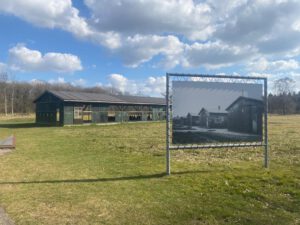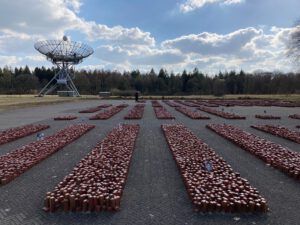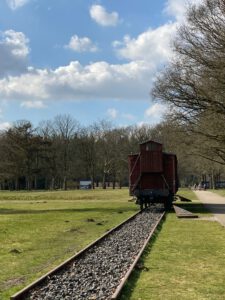By Luc Streuper, class of 2021
For the course Terrorscapes in Postwar Europe students went together with professor Rob van der Laarse on a fieldtrip to Kamp Westerbork: probably the best-known Dutch concentration camp due to its connection with Anne Frank. The course is all about how terrorscapes – places where traumatic events of terror took place – are remembered and managed from a heritage perspective. During the course many uneasy cases were discussed, which unveiled the complex and ambiguous relations between the terrorscape, memory, remembrance, victimhood, perpetrators and trauma. As an assignment all students wrote a report on the fieldtrip to Westerbork, focusing on one or several aspects of the camp as a terrorscape. My assignment below shows how I as a heritage student have acquired a critical approach to heritage sites which combines a theoretical background with on-site analysis..
Kamp Westerbork is a complicated heritage composition in which history and memory are fragmented into a rather obscure landscape. The website of the foundation that runs the campsite and the corresponding memory center describes its objective as giving meaning to this historical place.[1] I will describe how the foundation tries to do this, and why I think their approach shows room for improvement. Doing so, I will make use of the concepts of mimetic and anti-mimetic ways of viewing and experiencing the past.

Kamp Westerbork has not only been a Durchgangslager through which many Jews, Roma and Sinti have been deported to other camps in Eastern Europe. After the Second World War it was reused to detain Dutch collaborators. Later on ex-soldiers of the Dutch colonial army (KNIL) and their families were housed in the camp. After the near-complete destruction of the camp, radio telescopes were placed on its terrain. Consequently the site has a linear physical history, of which certain segments function as lieux de mémoires. The main goal of the foundation – to give meaning to this historical place – is thus a very complicated one, since several spiritual and intangible ‘places’ of memory are connected to the same physical ‘place’.

Remembering the places of trauma in Westerbork is done in two different ways. The memory center tells some individual stories of the people that experienced traumas in the camp. This is in accordance with how the foundation describes its target in storytelling in which ‘the camp tells the story of murder on one person, and does this 102.000 times’.[2] This personal connection that the foundations aims to establish between the visitor and the victims can be called a mimetic way of engagement. The goal is to emotionally reconstruct the past in order to engage with it. The campsite itself is an unorganized combination of barbed wire fences, memory monuments, radio telescopes, a house in a vitrine, train track parts, and information signs. All are placed haphazardly within the semi-open space that once was the camp. This approach is a rather anti-mimetic way of engagement. The idea of anti-mimetic engagement is trying to both frame and view the past from a distance.[3]
Violi (2014) argues that memetic and anti-memetic ways of engagement with the past both lead to different ways of remembering. The mimetic approach seeks to let visitors relive the historical experience – trauma in this case – whereas the anti-mimetic approach seeks to use the present as the frame of reference through which the past is viewed. Violi further describes the mimetic approach, in relation to memory, as a case of “not-able-to-forget”, and the anti-mimetic approach as “knowing-how-to-remember”.[4]
The problem that I identify at Kamp Westerbork is that both memetic and anti-mimetic approaches are used to remember what happened at the site. As most visitors will first visit the memory center, they will first mimetically engage with Westerbork’s dark past, and are thereafter expected to understand how they should remember and view the anti-mimetically staged campsite. This dichotomous approach fails to deliver both ways of viewing properly and leaves the visitor with two half experiences.
In their complicated task of remembering the fragmented history of Kamp Westerbork, the foundation uses two different ways of engagement, which may lead to a confusing experience for visitors. Kamp Westerbork could benefit from a more coherent approach to visitor engagement that seeks to connect the memory center with the campsite. This can be done by choosing either a mimetic or anti-mimetic approach. A partial reconstruction of the campsite could for instance provide a much needed mimetic element on the campsite, through which visitors may ‘experience’ what the camp was like. This will contribute to a more singular approach to remembering, that connects both the memory center and the campsite equally well to the important history of this traumatic site.

[1] Kamp Westerbork, consulted March 19, 2022, https://kampwesterbork.nl/de-stichting/algemene-informatie.
[2] Idem.
[3] Violi, M. P., 2014. Paesaggi della memoria. Il trauma, lo spazio, la storia. Milano, Bompiani, 54-55.
[4] Violi 2014, 55.